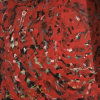I keep my ants with outworlds filled with about 1cm of dry fine white sand, simple decorations such as rocks. Ants destroy just about anything else. Dirt substrate, even if very shallow will be lumped up into mound and they will make strange little huts. Leaves and plants are shredded. Even driftwood is iffy. They will hollow it out and make little condos. Ants are resourceful and love to transform their environment.
So, "going bioactive" means basically having a natural nest and not seeing the ants in their nest anymore. This is how my Formica subsericea colony lives and it's nice, but I don't want to do that for all colonies.
Long and short of it is every day I use the tweezers to collect the exoskeletons of their meals. Every few weeks I scoop up the trash piles of empty cocoons, dead ants, seed husks, and who-knows-what. The ants seem to use the trash piles as their poop spot too, so this has the bonus of clearing out THAT issue too.
Then I just throw it all away.
But, I've been thinking about getting some pet isopods. I don't plan on keeping them with ants just yet, but I'm thinking I can give them the garbage in the name of recycling. I also wonder if there are any dry-loving detritivores who could live in the trash pile. The ants seem to find their trash piles gross and don't use the trash to make little huts like they do with dirt.
Have any of you had any luck "going bioactive" either by just having a crew in another container to eat their trash, or by finding some magical critter who doesn't need moist substrate to live but is happy to eat exoskeletons and ant garbage? The later seems unlikely but I thought I'd ask.
- Formiculture.com
- Forums
- Gallery
- Members
- Member Map
- Chat















